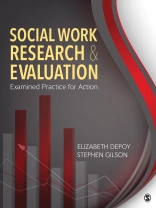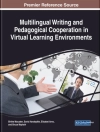Social Work Research and Evaluation applies systematically developed research knowledge to social work practice and emphasizes the ‘doing’ of social work as a reciprocal avenue for generating research evidence and social work knowledge. Using the Examined Practice Model, authors Elizabeth G. De Poy and Stephen F. Gilson present research as the identification of a problem and then proceed to evaluate the efficacy of social work practice in its resolution. Diverse theories, actions, and sets of evidence from a range of professional and disciplinary perspectives are included to underscore the importance of integrating evaluation and practice in research.
Daftar Isi
Chapter 1: Introduction to Examined Practice
Introduction to the Rationale for the Text
Illustration of Examined Practice in Diverse Social Work Settings
Roles and Responsibilities of “Examined Practitioners”
Chapter 2: Problems, Issues and Needs (What, Why, How, When, Where)
Definition of Terms
Thinking Processes of Problem and Issue Clarification
Grounding Needs in Problem and Issues to be Resolved
Chapter 3: Setting Goals and Objectives for Reflexive Intervention
Emergence of Goals and Objectives from Needs Statement
Deriving Goals From Need Statements
Action Process of Crafting Process Objectives
Action Process of Crafting Outcome Objectives
Charting Outputs
Systematic Reflexive Intervention Processes
Using the Three Traditions (Experimental-type, Naturalistic, Mixed Methods) in Reflexive Intervention
Selecting a Tradition—Guiding Questions
Illustration
Chapter 4: Exploring Outcomes
Definition of Terms
Purposes of Outcome Assessment
Worth of Social Work
Systematic Inquiry Using One or More of the Three Research Traditions
Cost of Interventions
Chapter 5: Sharing Examined Practice to Generate Social Work Knowledge
Definition of Terms
Examples of Sharing Knowledge
Sharing Social Work Knowledge
The Science-Intuition Debate
Why Share?
When to Share?
Where to Share?
How to Share?
Chapter 6: Two Design Traditions and then Mixing Them
Philosophical Foundation of Experimental-Type Research
Philosophical Foundation of Naturalistic Inquiry
Philosophical Foundation of Mixed Methods
Implications of Philosophical Differences for Systematic Inquiry in Examined Practice
Theory in Examined Practice
Integrating the Two Research Traditions
Chapter 7: The Role of Literature in Examined Practice
Purposes of Literature Review in Examined Practice
How to Conduct a Literature Search
Chapter 8: Questions, Hypotheses and Queries: The basis for Rigor Assessment
Research Questions in Experimental-Type Knowing
Level 1: Questions That Seek to Describe Phenomena
Level 2: Questions That Explore Relationships Among Phenomena
Level 3: Questions That Test Knowledge
Hypotheses
Research Queries in Naturalistic Inquiry
Developing Naturalistic Research Queries
Integrating Research Approaches
Chapter 9: Design in Both Traditions
Specific Experimental-Type Designs
Variations of Experimental-Type Design
Geographic Analysis
Criteria for Selecting Appropriate and Adequate Experimental-Type Designs
Summary of Experimental-Type Design
Naturalistic Inquiry Designs
Narrative Inquiry
Mixed-Method Designs
Chapter 10: Setting and Protecting the Boundaries of a Study
General Guidelines for Bounding Studies
Subjects, Respondents, Informants, Participants, Locations, Conceptual Boundaries, Virtual Boundaries
Protecting Boundaries
What is an IRB and When Must It Be Involved?
Principles for Protecting Human Subjects
Full Disclosure
Confidentiality
Voluntary Participation
The Belmont Report
Informed Consent Process
Boundary Setting in Experimental-Type Examined Practice Inquiry
Sampling Process
Probability Sampling
Nonprobability Methods
Sampling in the Virtual Environment
Comparing Sample to Population
Determining Sample Size
Boundary Setting in Naturalistic Inquiry
Guidelines for Determining “How Many”
Process of Setting Boundaries and Selecting Informants
Ethical Considerations
Summary of Naturalistic Boundary Setting
A Few Words About Mixed Methods
Chapter 11: Obtaining Information
Principles of Information Collection in All Three Traditions
Looking, Watching, Listening, Reading, and Recording
Asking
Materials, Artifacts, or Spaces
Obtaining Information in Experimental-Type Traditions
Obtaining Information in Naturalistic Traditions
Information-Gathering Processes
Information-Gathering Strategies
Recording Obtained Information
Accuracy in Collecting Information
Mixing Methods
Chapter 12: Analysis
What Is Statistical Analysis?
Level 1: Descriptive Statistics
Level 2: Drawing Inferences
Level 3: Associations and Relationships
Strategies and Stages in Naturalistic Analysis
Stage One: Inception of Inquiry
Stage Two: Formal Report Preparation
Accuracy and Rigor in Naturalistic Analysis
Chapter 13: Putting the Model to Work
Themes
Exemplar #1—Janice
Exemplar #2—Dean
Exemplar #3—TAP (Tobacco Access Portal)
Exemplar #4—Aesthetic Mobility Device Project
Exemplar #5—Workplace Accessibility
Glossary
Index
Tentang Penulis
Stephen Gilson is professor at the University of Maine where he teaches human behavior in the social environment, diversity theory, and biology for social workers. His own work is informed by systematic inquiry and thus he is committed to the synthesis of practice and research within social work. Stephen has authored/coauthored 12 books and over 80 articles including Branding and Designing Disability and Evaluation Practice. He presents his work nationally and internationally.












